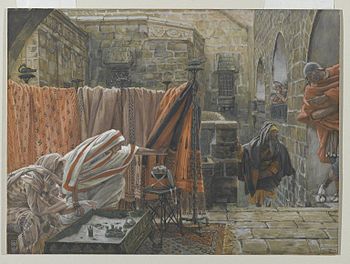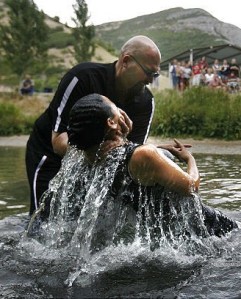When morning came, the Sanhedrin had Jesus taken to Pilate. When Judas saw that Jesus was condemned, he had a change of heart, and took the thirty pieces of silver back to them, saying that he had betrayed innocent blood. But they are unimpressed. So he threw it down in the temple and went and hanged himself. Remorse, as we see, does not always include repentance. The Sanhedrin has no problem with lies and the murder of an innocent man, but they want no part of this blood money, so they use it to buy a potter’s field. The scripture that this fulfilled, referred to in verses 9-10, is from both Jeremiah 19:1-13 and Zechariah 11:11-13.
Jesus answers Pilate’s question of whether He was a king, but remains silent about the charges against Him. We find in verse 20 that the chief priests and elders persuaded the people to choose Barabbas when Pilate offered to free one of them. Fearing a riot, Pilate resigns himself to the will of the crowd, but uses the physical act of washing hands to declare his innocence of “this man’s blood.” “Having scourged Jesus” is mentioned in passing, but this Roman form of flogging was anything but incidental. It was a brutally painful beating with a whip weighted with sharp pieces of bone and metal. It was designed to lacerate, often exposing bone and intestines. Crucifixion was an agonizing and tortuous death, but this beating would be equally painful. A good article on this scourging can be found at this link.
He was mocked and spit upon, stripped and made to wear a crown made of thorns. Then he was led away to be crucified. They made a man named Simon of Cyrene to carry His cross, and when they reached Golgatha (which means Place of a Skull), they tried to give him wine mixed with gall (a very bitter herb that could also be poisonous) to drink. It was intended to dull the sense of pain, but it was God’s will that He should suffer. As they crucified Him, “they divided his garments among them by casting lots” – referring to Psalm 22:18. Verses 36-44 detail the continued derision, mocking and reviling inflicted on Him as He suffered.
Crucifixion was a slow and excruciatingly painful method of inflicting death, and there are many stories of the cruelty of Roman soldiers experimenting with different poses for crucified victims (Josephus, “Jewish War” 5.449–551). Hanging by one’s arms caused great difficulty in breathing, only alleviated by the victim pushing up with their feet in order to take the weight off of the arms. But that caused severe pain in the feet, arms, legs, and back, making the exhausted victim slump down again, only to be barely able to breathe again. Finally, he would mercifully die of asphyxiation, if he had not already died as a result of the cumulative effects of the multiple physical traumas inflicted.
In verse 45, there was darkness all over the land from the 6th hour until the ninth hour (about noon to 3:00). About the ninth hour, Jesus cried out with a loud voice “Eli, Eli, lema sabachthani?” meaning, “My God, my God, why have you forsaken me?” This is from Psalm 22:1. This is one of the most puzzling verses in the Bible. Jesus knows what is happening, and why He is doing it. One explanation that has been posed is that because Jesus did in fact become sin, at this moment Jesus felt the presence of God turn away from Him as He was dying. Jesus then gave up the spirit with another cry.

Joseph of Arimathaea Seeks Pilate to Beg Permission to Remove the Body of Jesus (Photo credit: Wikipedia)
Then in verse 51, the curtain of the Temple was torn from top to bottom. It was between the Holy Place and the Most Holy Place, and was woven from 72 twisted plaits of 24 threads a piece. It was 60 feet high and 30 feet wide. No one was allowed to enter the Most Holy Place behind the curtain except the high priest, and then only on the Day of Atonement. Being torn in two represents the removal of the separation between God and the people. A high priest was no longer needed – Jesus is our high priest now. More elaboration of this event, and what it symbolized, is in Hebrews 9:11–10:22. Then the earth shook (Palestine sits on a major seismic rift), rocks were split, and tombs were opened. As Matthew often groups events together topically, he then jumps ahead here in verse 53 to events after the resurrection, as many of the saints were raised and came out of the tombs to appear to many in the city. We are not told whether they were taken to heaven after these eyewitnesses received these visits. But clearly, God wanted many witnesses to understand the profoundly momentous significance of what had happened.
In verse 57, a rich man from Arimathea named Joseph came to Pilate that evening to request Jesus’ body. He took the body and wrapped it in a linen shroud and placed it in his own tomb. This fulfilled Isaiah 53:9. Then he rolled a big stone in front of the entrance. Then the chief priests, remembering how he had said that he would rise after 3 days, went to Pilate voicing their fears that Jesus’ disciples might come and steal the body. So he gave them a guard of soldiers, and they sealed the tomb and stood guard.
After the resurrection, Jesus – as He had told the disciples in Matthew 26:32 that He would meet them there – would be with them at the Sea of Galilee, and at a mountain there that He directs them to. But several other events occur before and after this, the details of which are interspersed throughout the gospels in Luke 24 and John 20. And events in a single chapter are in some cases separated by days, and even weeks, as Jesus remained for forty days before the ascension.)
Then some of the guard that had been on watch at the tomb went to the chief priests to tell them what had happened. After deliberating, they gave money to the guards to have them say that His disciples had come and stolen the body while they were asleep, promising to keep them out of trouble if word got back to Pilate. Their acts of unbelief in the face of these eyewitness accounts is stunning, but such was their love for power that they would not let it be jeopardized.
Jesus meets His apostles in verse 16 on the mountain in Galilee that He had directed them to. In verses 18-20, Jesus gives the eleven chosen ones the Great Commission – to go and make disciples of ALL nations “baptizing them in the name of the Father and of the Son and of the Holy Spirit, teaching them to observe all that I have commanded you.” Jesus has confirmed that His Kingdom is open to everyone. Because this is the end of Matthew, some confuse this event with the time of the ascension. But that comes later at at a different mountain – Mount Olivet, after they returned to Jerusalem.
/Bob’s boy
Bible Reading Schedule for this month
Click links below to read or listen to audio of one of this week’s chapters in Colossians and Luke
Matt 26, Matt 27, Matt 28, 1 Cor 1, 1 Cor 2
___________________
some images © V. Gilbert & Arlisle F. Beers
Please visit this site’s menu item “The Author’s Books” for info on the author’s books, website, and Facebook page.
All of my comments in this blog are solely my responsibility. When reading any commentary, you should always refer first to the scripture, which is God’s unchanging and unfailing word.















